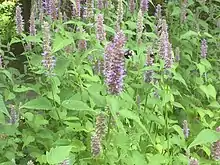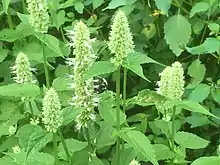Agastache foeniculum
Agastache foeniculum (blue giant hyssop; syn. Agastache anethiodora (Nutt.) Britton), commonly called anise hyssop, blue giant hyssop, Fragrant giant hyssop, or the lavender giant hyssop, is a species of perennial plant in the mint family, (Lamiaceae). This plant is native to much of north-central and northern North America, notably the Great Plains and other prairies, and can be found in areas of Canada.[1][2] It is tolerant of deer and drought, and also attracts hummingbirds, butterflies,[3] bumblebees, honeybees, carpenter bees, and night flying moths.[4]
| Agastache foeniculum | |
|---|---|
 | |
| Scientific classification | |
| Kingdom: | Plantae |
| Clade: | Tracheophytes |
| Clade: | Angiosperms |
| Clade: | Eudicots |
| Clade: | Asterids |
| Order: | Lamiales |
| Family: | Lamiaceae |
| Genus: | Agastache |
| Species: | A. foeniculum |
| Binomial name | |
| Agastache foeniculum | |
Anise hyssop is in the same family as hyssop (the mint family Lamiaceae), but they are not closely related. Hyssop (Hyssopus) is a genus of about 10-12 species of herbaceous or semi-woody plants native from the east Mediterranean to central Asia.[1]
Description
This species grows from 2 ft (61 cm) to 4 ft (120 cm) tall and 1 ft (30 cm) wide, in a clump-like, upright shape, with flowers appearing in showy verticillasters, or false whorls, and occasionally branching at the apex.[5] The leaves have an oval, toothed shape with a white tint underneath. The plant blooms in June to September with bright lavender flowers that become more colorful near the tip.[3][6] One plant may produce upwards of 90,000 individual flowers.[7] The root system produces a taproot.[5]
Pollinators

Anise hyssop is considered one of the premier plants for feeding pollinators. The 1969 edition of the Rodale's Encyclopedia of Organic Gardening claims that one acre planted in anise hyssop can support 100 honeybee hives, the flowers blooming for a very long season, often from June until frost and during the time it blooms, one can see bees on the flowers from the morning until dusk.[8] A horticultural writer has claimed that the many flowers of the plant provide forage for bees, butterflies and hummingbirds.[9]
Uses
Anise hyssop was used medicinally by Native Americans for cough, fevers, wounds, diarrhea. The soft, anise-scented leaves[6] are used as a seasoning, as a tea, in potpourri, and can be crumbled in salad. The purple flower spike is favored by bees who make a light fragrant honey from the nectar.[10]
External links
| Wikispecies has information related to Agastache foeniculum. |
| Wikimedia Commons has media related to Agastache foeniculum. |
References
- "Agastache foeniculum". Natural Resources Conservation Service PLANTS Database. USDA.
- "Agastache foeniculum". County-level distribution map from the North American Plant Atlas (NAPA). Biota of North America Program (BONAP). 2014.
- "Agastache foeniculum". Missouri Botanical Gardens. Retrieved 20 December 2013.
- Ayers, George (July 1994). "The Genus Agastache as Bee Forage: An Analysis of Reader Returns". American Bee Journal (134): 480–482.
- Hilty, John (2016). "Anise hyssop". Illinois Wildflowers. Retrieved 20 December 2013.
- "Agastache foeniculum (Anise hyssop)". Fine Gardening. Retrieved 20 December 2013.
- Pan, Ziliang. "Bee Visitation and Nectar Production of Anise Hyssop" (PDF). Retrieved 16 August 2019.
- Rodale, J.I. (1969). The Encyclopedia of Organic Gardening. Emmaus Pennasylvania. pp. 522–523.
- Kagan, Carol. "Anise Hyssop for the Perennial Garden". PennState Extension. Retrieved 13 August 2019.
- "Herbs"; Smithsonian Handbook - Lesley Bremness